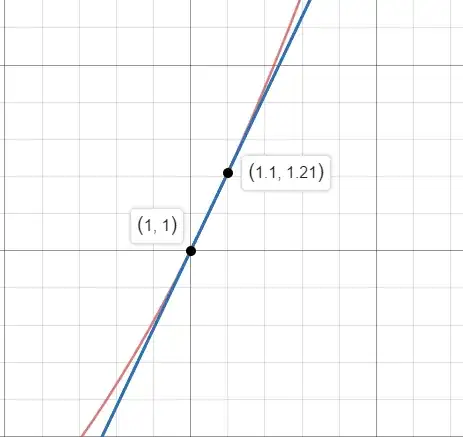Here is my answer
from an earlier question
(How is the derivative truly, literally the "best linear approximation" near a point?),
which shows that
the tangent is the best
local linear approximation to the function
at a point:
I'll first give a intuitive answer,
then an analytic answer.
Intuitively,
the tangent goes
in the same direction
as the function,
following it as
closely as possible
for a line.
Any other line
immediately starts to diverge
from the function.
Analytically:
Consider the Taylor aproximation
at $x$:
$f(x+h)
=f(x)+hf'(x)+h^2f''(x)/2+...
$.
This means that,
for small $h$
$f(x+h)
\approx f(x)+hf'(x)+h^2f''(x)/2
$
so that
the error
$E(x, h)
=f(x+h)- (f(x)+hf'(x))
$
is about
$ h^2f''(x)/2
$.
Now consider any other line
through $(x, f(x))$
with slope $s$,
with $s \ne f'(x)$.
At $x+h$,
its value is
$f(x)+sh$,
so its error,
$e(x, h)$ is
$e(x, h, s)
=f(x+h)-(f(x)+sh)
$.
Since
$f(x+h)-f(x)
\approx hf'(x)+h^2f''(x)/2
$,
$\begin{array}\\
e(x, h, s)
&=f(x+h)-(f(x)+sh)\\
&\approx hf'(x)+h^2f''(x)/2-sh\\
&= h(f'(x)-s)+h^2f''(x)/2\\
\end{array}
$
so that
$\dfrac{E(x, h)}{e(x, h, s)}
\approx \dfrac{h^2f''(x)/2}{h(f'(x)-s)+h^2f''(x)/2}
= \dfrac{hf''(x)/2}{f'(x)-s+hf''(x)/2}
$.
Since $s \ne f'(x)$,
as $h \to 0$,
the numerator of thie
ratio of errors
goes to zero,
while the denominator
stays bounded away from zero.
Therefore
the error of the tangent
goes to zero faster than
the error in any other line
through the point.
That is why the tangent
is the best linear approximation
to the curve.
